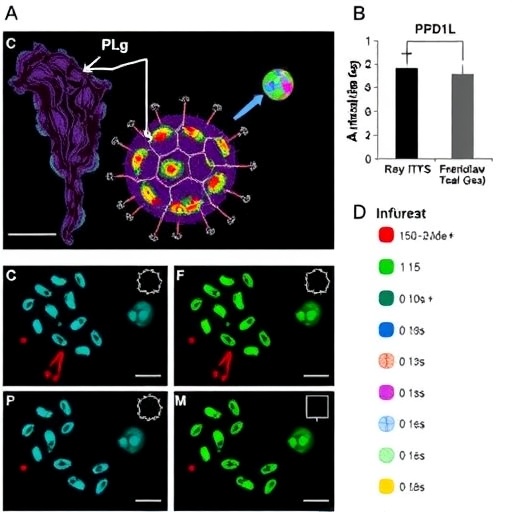Recent research by Huang and Sun has illuminated potential concerns surrounding the involvement of GPD1L in the infiltration of regulatory T cells (Tregs) and the intriguing role of lipid metabolism in clear cell renal cell carcinoma (ccRCC). This challenging cancer type, known for its aggressive nature and propensity for metastasis, poses significant therapeutic hurdles. The current discourse on GPD1L sets the stage for a deeper understanding of tumor biology, particularly in the context of immune responses and metabolic pathways.
Clear cell renal cell carcinoma is characterized by a unique cellular composition that significantly influences its progression and treatment responses. Tregs are a subset of immune cells that modulate the immune response, often working to suppress the activity of other immune cells. However, their infiltration into tumors can create a microenvironment that allows cancer cells to escape immune surveillance. Understanding the role of GPD1L in this process could offer novel insights into therapeutic strategies aimed at rebalancing immune responses in ccRCC.
GPD1L, or glycerol-3-phosphate dehydrogenase 1-like, is being studied for its effect on lipid metabolism. Lipid metabolism plays a critical role not only in providing energy to cells but also in influencing signaling pathways that govern cell survival and proliferation. In ccRCC, where metabolic reprogramming is often observed, the interaction between GPD1L and lipid metabolism could have far-reaching implications. This link between metabolism and immune function represents a frontier in cancer research that could lead to innovative therapeutic targets.
The authors raise methodological concerns regarding the interpretation of GPD1L’s role in these complex interactions. One area of focus is the need for rigorous experimental design to disentangle the effects of GPD1L on Treg infiltration from other confounding factors present in tumor microenvironments. Without such considerations, the conclusions drawn about GPD1L’s role may be oversimplified or misrepresented. This underscores the importance of rigorous methodologies in research, particularly in cancer studies that can have life-or-death implications for patients.
Additionally, Huang and Sun address the implications of aberrant lipid metabolism in the pathology of ccRCC. Tumors often exhibit altered lipid profiles, which can affect both their growth and the immune response to them. By investigating how GPD1L interacts with these metabolic pathways, there is potential to identify novel biomarkers that could improve prognostic assessments and treatment strategies for patients with ccRCC.
The immune environment in ccRCC remains a focal point in the ongoing battle against cancer. Tregs, while essential for maintaining tolerance and preventing autoimmunity, can also aid tumor progression by dampening effective anti-tumor immune responses. The infiltration of Tregs into tumors has been correlated with poorer outcomes in various cancers, emphasizing the need for targeted therapies that can selectively modulate these cells’ behavior within the tumor microenvironment.
Huang and Sun’s work adds to a growing body of literature exploring the connections between metabolism and immunity within the cancer context. With ccRCC presenting unique challenges, understanding the nuances of these relationships could lead to more effective therapeutic interventions. For instance, modulating GPD1L’s activity might not only alter lipid metabolism but could also invigorate T cell responses against the tumor, offering a dual mechanism of action.
Moreover, the authors encourage the scientific community to pursue interdisciplinary approaches that combine insights from metabolic research, immunology, and oncology. By leveraging diverse methodologies, researchers might better understand how metabolic alterations in tumors like ccRCC can affect immune cell dynamics and treatment outcomes. Such collaborations across fields could accelerate the discovery of new therapeutic avenues that improve patient prognosis.
The implications of this research extend beyond ccRCC, as similar mechanisms may operate in other cancers characterized by metabolic reprogramming and immune evasion. By focusing on the interlinked roles of metabolism and regulatory T cell dynamics, future studies may pave the way for broader advances in cancer therapy and prevention, potentially reshaping strategies to combat various malignancies.
Investing in this area of research could uncover not only the fundamental biology driving ccRCC but also lead to the development of precision medicine approaches. As oncologists and researchers work together to dissect these complex relationships, it is critical that they maintain a clear focus on patient outcomes, ensuring that scientific advancements translate into real-world benefits for individuals battling cancer.
As the field continues to evolve, it will be essential to consider how findings from studies like those conducted by Huang and Sun could inform clinical practice. Researchers must emphasize the importance of clinical validation for discoveries made in laboratory settings. Only through comprehensive studies that incorporate clinical outcomes can the true impact of GPD1L on Treg infiltration and lipid metabolism be fully appreciated and potentially harnessed for therapeutic gain.
In summary, the interplay between GPD1L, Treg infiltration, and lipid metabolism in clear cell renal cell carcinoma presents both challenges and opportunities for cancer research. Huang and Sun’s investigation calls attention to critical methodological concerns that could shape our understanding of these complex interactions. As research progresses, a nuanced view of these relationships will be paramount for developing innovative strategies that effectively target ccRCC and improve patient outcomes in the future.
By addressing these intricate pathways and their implications for immune modulation and metabolism, scientists may ultimately unveil a robust framework for approaching ccRCC therapy. Continued dialogue in the scientific community will be crucial as researchers strive to translate their findings into actionable strategies for combating one of the most formidable opponents in the cancer landscape.
Subject of Research: GPD1L’s role in Treg infiltration and lipid metabolism in clear cell renal cell carcinoma.
Article Title: Methodological concerns regarding the role of GPD1L in Treg infiltration and lipid metabolism in clear cell renal cell carcinoma.
Article References:
Huang, W., Sun, A. Methodological concerns regarding the role of GPD1L in Treg infiltration and lipid metabolism in clear cell renal cell carcinoma.
J Transl Med 23, 1315 (2025). https://doi.org/10.1186/s12967-025-07396-0
Image Credits: AI Generated
DOI: https://doi.org/10.1186/s12967-025-07396-0
Keywords: Clear cell renal cell carcinoma, Tregs, GPD1L, lipid metabolism, cancer immunology, methodology.
Tags: aggressive cancer and lipid metabolism.ccRCC treatment challengesglycerol-3-phosphate dehydrogenase 1-like studiesGPD1L and Treg infiltrationGPD1L function in cancer biologyimmune response modulation in ccRCCimmune surveillance and cancer evasionlipid metabolism in clear cell renal cell carcinomametabolic pathways in renal cell carcinomarole of Tregs in tumor microenvironmenttherapeutic strategies for clear cell RCCtumor biology and immune interactions





